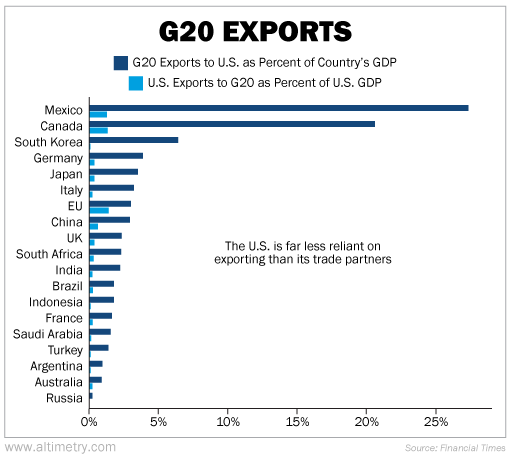 Trump is back to one of his favorite bargaining chips...
Trump is back to one of his favorite bargaining chips...
The president has never shied away from tariffs. Yet so far, many of his biggest threats haven't materialized.
He started targeting the U.S.'s closest trading partners, Canada and Mexico, with steep tariffs earlier this month... only to pause them. A similar tug-of-war has played out with China over the years.
Trump has long argued that the trade deficit is a major problem for the U.S. He thinks other countries are ripping us off and that tough negotiations are essential.
In short, this tariff game isn't anything new. Trump will likely keep using them as a long-term tactic.
Today, we'll take a closer look at what that could mean for U.S. trade partners.
 Tariffs hurt both sides of a trade...
Tariffs hurt both sides of a trade...
We mentioned earlier this week that tariffs could harm the U.S. economy – and hit other countries even harder.
You can get a better sense of the full impact through the following chart. It shows the U.S.'s trade relationship with every other member of the Group of 20 (G20)... an international forum of 20 major emerging and developed economies.
As you can see, the U.S.'s highest exports-to-GDP ratio – reflecting its exports to Canada – is a mere 1.28%. Our exports to Mexico come in second place, at just 1.16%.
Compare that with Canada's exports-to-GDP ratio for the U.S., which is much higher at 20.6%. Mexico's ratio is a tremendous 27.4%.
Take a look...

Every U.S. trading partner in the G20 sends us more goods relative to GDP than we send them.
Simply put, these nations depend on U.S. demand far more than we depend on theirs. This is what gives us the upper hand when negotiating tariffs.
 That leverage could help Trump achieve his big goal... to have more Americans buy 'American'...
That leverage could help Trump achieve his big goal... to have more Americans buy 'American'...
It would certainly strengthen the U.S.'s position in global trade, making it even easier to play hardball.
Mexico, China, and Canada make up more than 40% of all U.S. imports as of 2024... adding up to a whopping $1.4 trillion.
That's why these countries are in Trump's crosshairs. It's why he wants to replace a big chunk of these imports with domestic production.
However, that's not as easy as it sounds. And it could come at a huge cost.
Tariffs would mean higher prices for goods and services, which would pass to consumers. In other words, American families would end up paying more.
The damage would be much greater for Mexico and Canada, though. Both stand to lose a significant slice of GDP.
 The big question is... How much of the tariff talk is real?
The big question is... How much of the tariff talk is real?
Trump has a history of making bold threats, only to pause or roll them back when he gets what he wants.
But many other countries can't afford to reject these offers. They depend on exports to the U.S. for survival. So they're often left with no choice but to meet Trump's demands.
That's what makes tariffs such a powerful tool in international negotiations... even when they're not fully implemented.
We're bound to see far more tariff talk while Trump is in office. Keep in mind, they're a negotiation tactic. There's no reason to panic right away.
Regards,
Joel Litman
February 27, 2025



 Trump is back to one of his favorite bargaining chips...
Trump is back to one of his favorite bargaining chips...


